 |
 |
 |
| |
High Referral of HCV Patients to Specialists But Low Treatment Initiation Rate - Barriers to Care & Treatment
|
| |
| |
IDWeek, October 2-6, 2013, San Francisco
from Jules: authors told me this study was conducted during the time period for pegylated interferon+ribavirin use. So for me a question is will these same barriers persist and to what degree if they do after new improved therapies about to be approved are available. In addition there are other barriers not addressed in this poster so how much will these barriers create difficulty in accessing care & treatment. Of course the barriers to initial diagnosis are the first concern, how will we diagnose the 75% we think are undiagnosed in the USA, estimated to be as many as 5 million undiagnosed. Second, how will we develop an adequate care infrastructure capable of accommodating so many patients, and will this care system be effective with adequately qualified care providers. I have doubts that primary care & untrained providers with no experience in hepatitis C can be trained to treat the disease. Third, how will we accommodate the hardest to treat patient populations: marginalized patient populations, IDUs, this will not be easy as this will take commitment to build a healthcare infrastructure with the ability to provide the specialized resource-intensive these patient populations will need. And within the IDU community there are gradations of difficult-to-treat patients, in particular there are patients that most providers do not want to treat, these are the most marginalized IV drug users who the healthcare system does not want to treat, they can be dirty, homeless, using IV drugs & alcohol, have psychiatric disorders, poor communication skills, unable to navigate healthcare system, mistrusting of the healthcare system, uneducated, but want to be cured, so we need to create a system that can & will treat these patients, it is doable. We can create a successful healthcare facilities system for them, we have to be creative.
Mark Mascolini
More than 90% of patients with HCV infection at an academic primary care practice got referred to a hepatitis specialist [1]. But for most patients more than a year passed between HCV diagnosis and referral, and only 18% of patients with a documented specialist visit started anti-HCV therapy.
Prompt diagnosis, referral, and possibly treatment of HCV infection are essential to preventing complications. Rapid referral and treatment might be considered even more urgent since licensing of direct-acting antiretrovirals that could induce sustained virologic response in more people. To assess HCV referral and treatment rates in their academic primary care practice, investigators at Baystate Medical Center/Tufts University in Massachusetts conducted this retrospective cross-sectional study. The researchers aimed both to describe referral and treatment patterns and to identify traits that favored or delayed referral and treatment.
The study focused on people making one or more office visits in the past 2 years who were diagnosed with HCV and not already in care with an infectious diseases or HCV specialist. Among 235 people eligible for the study, 215 (91.5%) got referred to a hepatitis specialist and 20 did not. But among those 215 referred patients, only 146 (68%) had a documented visit with an HCV specialist. Among the146 people with a documented specialist visit, 26 (17.8%) got treated for HCV infection and 120 did not. Among treated people, median time from referral to starting therapy was 226 days (interquartile range 157 to 376).
Among the 120 people not treated after a documented HCV specialist visit, reasons for lack of treatment included loss to follow-up, patient preference, psychiatric factors, substance abuse, and undetectable HCV load. Among the 20 patients with an HCV diagnosis not referred to an HCV specialist, (overlapping) reasons for lack of referral were active substance abuse (9 people), patient preference (7), psychiatric disorders (6), and other reasons (4).
Compared with the 146 referred people who had a documented HCV specialist visit, the 69 who did not were less likely to be married (5.8% versus 28.7%, P < 0.01) and marginally less likely to have any comorbidity (17.4% versus 29.7%, P = 0.07) or to be HIV-positive (4.4% versus 11.9%, P = 0.13). In this analysis, gender, race, age, injection drug use, psychiatric conditions, and severity of HCV infection did not distinguish between patients who did and did not have an HCV specialist visit.
Median time from HCV diagnosis to specialist referral was 411 days (interquartile range 33 to 1390). Time-to-event analysis identified three factors that favored a shorter median time to referral: being married (71 versus 184 days, P< 0.001), being HIV-positive (66 versus 156 days, P = 0.045), and having any comorbidity (83 versus 179 days, P = 0.009).
The researchers suggested the high referral rate reflects a practice setup in which primary care and specialty services share electronic medical records and ancillary staff. The correlation between being married and prompter referral may mean marital status is a proxy for social support that could enhance adherence. The link between HIV coinfection or comorbid conditions and faster referral may reflect more frequent clinic visits by these patients and thus increased provider awareness.
The investigators called for prospective studies to confirm their findings. They suggested that new, simpler, less toxic HCV regimens may prompt faster patient referral and treatment initiation.
Reference
1. Ooi WB, Madero-Gorostieta F, Dahiya S, et al. Referral and treatment patterns in chronic hepatitis C. IDWeek 2013. October 2-6, 2013. San Francisco. Abstract 465.
-------------------------------------------------------------
Reported by Jules Levin
Referral and Treatment Patterns of Chronic Hepatitis C
Wei B. Ooi MD, Fernando Madero-Gorostieta MD, Saurabh Dahiya MD, Michael Rosenblum MD,
Alexander Knee, Armando Paez MD, Daniel Skiest MD
Baystate MedicalCenter/Tufts University School of Medicine

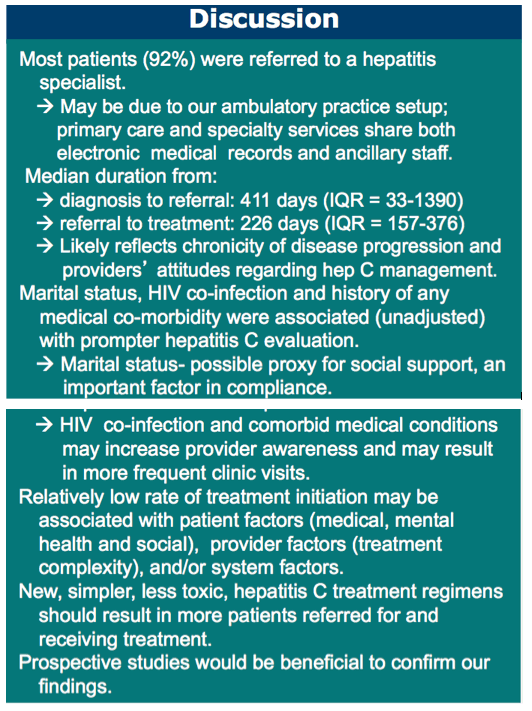
Program Abstract
Background: Hepatitis C virus (HCV) infection is a common blood-borne disease in the United States; approximately 3.2 million people are infected chronically. Prompt evaluation for possible treatment is important to avoid complications of HCV infection.
Methods: This was a retrospective cross-sectional study at an academic primary care practice. The objectives were to describe referral and treatment patterns of HCV infection and identify patient characteristics associated with delay in HCV care. HCV-infected patients were identified based on ICD-9 billing codes.
Exclusion criteria included missing electronic medical records and patients followed by a HCV specialist prior to their initial presentation to our practice. Patient characteristics associated with delay in HCV care were determined using time-to-event methods. Differences were evaluated using Kaplan-Meier plots and log-rank tests.
Results: Two hundred and thirty five patients were included, of which 215 were referred to a HCV specialist. Mean age was 50 years. Sixty four percent were male and fifty six percent were white. Median duration from HCV diagnosis to referral to HCV specialist was 411 days. Median duration from referral to HCV specialist visit was 71 days. Thirty two percent of 215 patients who were referred did not have a documented specialist visit. Only twenty six patients (11%) were started on HCV treatment and the median duration from referral to initiation of treatment was 226 days. Primary care providers or HCV specialists' reasons for no referral and no HCV treatment, respectively, included patient preference, substance abuse, psychiatric disorders, lost to follow-up and others. Patient characteristics associated with an earlier assessment of Hepatitis C included marital status, HIV co-infection and history of any medical co-morbidity.
Conclusion: Most HCV- infected patients were referred to a HCV specialist. However, HCV treatment was infrequent with a prolonged duration from time of diagnosis to treatment. Patient, physician and system factors need to be addressed to improve care.
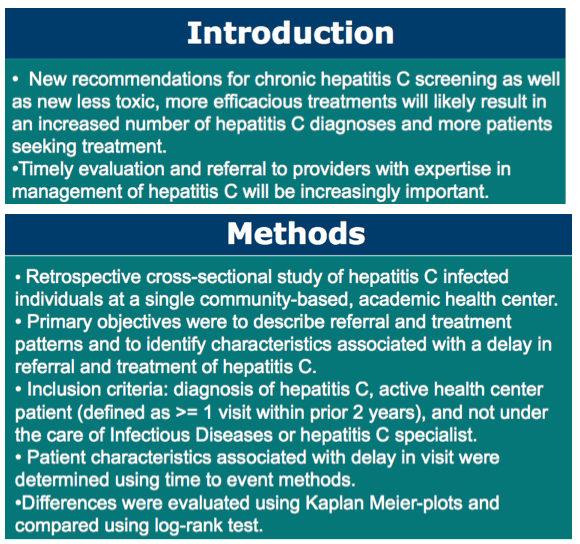
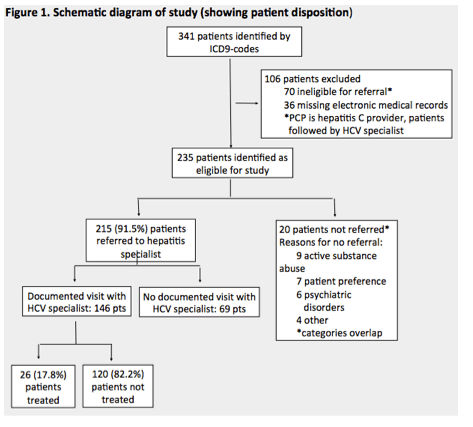
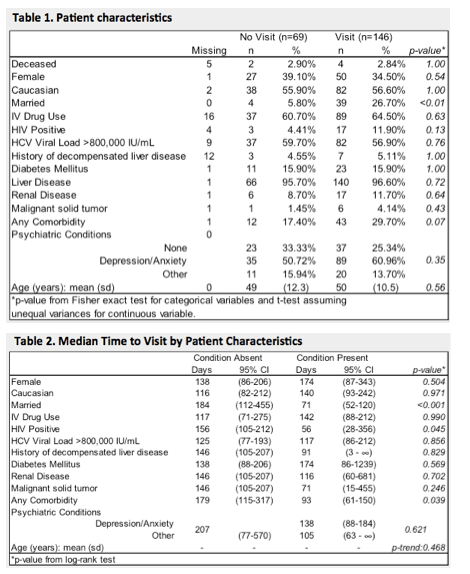
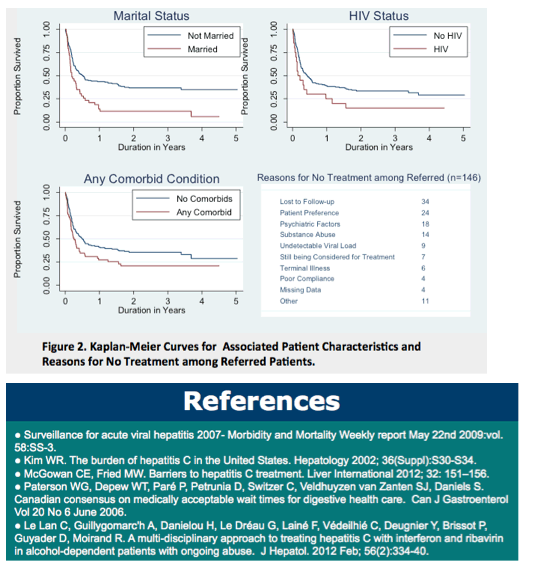
|
| |
|
 |
 |
|
|